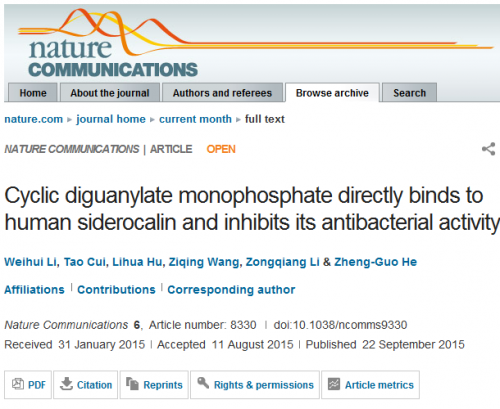
On Sep. 22nd, Nature Communications published online the latest findings by professor He Zhengguo team of the National Key Laboratory of Agricultural Microbiology in HZAU on the interaction between pathogenic bacteria and hosts. The paper Cyclic Diguanylate Monophosphate Directly Binds to Human Siderocalin and Inhibits Its Antibacterial Activity reported for the first time a new mechanism of pathogenic bacteria using their second messenger molecules as a new weapon to break through the defense system of hosts.
The interaction between pathogenic bacteria and host cells, long regarded as a hot research topic and a frontier problem in the field of microbiology and immunology, has attracted continuous attention from scientists. However, such issues remain quite unclear as how pathogenic bacteria use their metabolites to attack the immune system of host cells, so as to achieve the aim of infecting and overturning host cells. Recently, He Zhengguo team found that M. tuberculosis and E. coli can use self-secreted signaling molecules called Cyclic Diguanylate Monophosphate (c-di-GMP) to attack hosts’ immune system, so as to remove nutrition restriction of host cells on the growth of pathogenic bacteria and promote the survival of the pathogen in the hosts. The research project is done independently by the State Key Laboratory of Agricultural Microbiology in HZAU, with three graduate students Li Weihui, Cui Tao and Hu Lihua as joint first authors of the paper (This is part of the work of their doctoral dissertations) and professor He Zhengguo as corresponding author.
It is reported that iron is a kind of microelement which is vital to almost all living bodies. In the process of infecting hosts, pathogenic bacteria must get enough iron from the hosts to survive. Therefore, a kind of molecule called siderophore compounded and secreted by bacteria combines itself with iron ions in the hosts, and then take them back to the interior of bacteria. In response to the "stealing" of iron by bacteria, hosts use siderocalin to fight back. Siderocalin can chelate siderophore, making the latter a "capture" with no return, thereby blocking iron ion transportation "route" of bacteria and trying to "starve" the bacteria. The team’s research results show that in the face of the "encirclement "of hosts, instead of just "sitting around", bacteria use c-di-GMP to attack Siderocalin. The study found that c-di-GMP can attack the siderophore binding site of the siderocalin, relieving the "captivity" of siderophore to restore the iron ion transportation "route" of bacteria, thus promoting effective survival of bacteria in the hosts. Fights between the bacteria and the host are really like a saying: "while the priest climbs a post, the devil climbs ten".
The researchers said that c-di-GMP is a ubiquitous signal molecule in bacteria, so this finding may represent a general strategy used by pathogenic bacteria to overcome the defense system of hosts, which is of great significance for knowing the molecule mechanism of pathogen breaking through hosts’ defense as well as antibacterial drug design in the future.
By Wang Jingjing